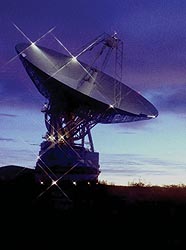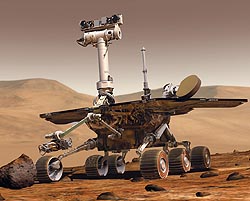|
(This is the second in a two-part series about IBEW members
who work for NASA)
November 2004 IBEW Journal
Contractors
Come
and Go: IBEW Stays
Since 1972, Local
543 has represented a diverse cut of the Goldstone work
forcefrom cooks and electricians to janitors and technicians.
Koger recalls that when she was hired, Goldstone tracked manned
space missions. Currently only unmanned missions are followed.
"The last person we tracked in space was former Senator
and astronaut John Glenn, five years ago," Koger said.
The IBEW has seen contractors
come and go at Goldstone beginning with Ford Aerospace, followed
by Bendix, Allied Signal, Honeywell and finally, ITT. The
revolving door of contractors at most NASA facilities (see
box), keeps many local unions in a state of perpetual bargaining.
The IBEW secured a commitment
from ITT in 2003 to honor the existing agreement that was
bargained with Honeywell. The schedules can be demanding.
Heck worked middle shift for five years before using his seniority
to transfer to daylight hours. "I feel like I have a
normal life again since I went back to working days, after
working middle shift," says Scott Heck.
Current rates of pay for bargaining
unit members range from $16 per hour for janitors to over
$25 per hour for technicians. The local won an agreement from
ITT to consider pay upgrades for members who, according to
Ray Gibson, are "constantly in learning mode."
Space Explorations
Discoveries Belong to All
 70
meter antenna-Goldstone Deep Space Communications Center 70
meter antenna-Goldstone Deep Space Communications Center
Gibson, the self-defined "space
person" says, "So much of the technology that we
didnt have 10 years ago came from the space program."
But, when federal budget deficits are grabbing headlines,
are the discoverieswhich IBEW members fought to preserve
at Goddard Space Centerand the innovations emerging from
Goldstone, worth their price?
The answer is as close as your
cell phone, your digital camera or your latest CAT scan. Todays
wireless communications are the direct product of data transmissionsby
deep space antennasthe work of Brotherhood members in California
and other locations throughout the U.S.
Digital image processing derived
from the Ranger spacecraft of the 1960s. Computer Aided Tomography
(CAT) scanning and ultrasounds were born in the digital images
of space sent back to Earth by the Mariner 4 probe in 1965.
More recently, the same miniaturization
technology that created spacecraft sensors has led to the
development of equipment that can detect cataclysmic medical
and geological occurrences from cancer to earthquakes.
In 1966 Isaac Asimov, the science
fiction writer and the inspiration for the box-office hit
"I Robot," wrote Fantastic Voyage, featuring a miniaturized
doctor roving a patients body to clear a blood clot. Today,
the JPL has come a hairs breadth of this mythical world,
contributing to the development of a camera chip that is inserted
in a pill. The pill, once swallowed, can photograph a human
digestive system.
The sensing systems on the Mars
Odyssey mission that detected frozen water on Mars may, according
to a JPL brochure, "have applications for remote detection
of materials on Earth."
 One
of Twin Rovers getting ready to drill into a rock on Mars One
of Twin Rovers getting ready to drill into a rock on Mars
While some IBEW members converse
with robots on Mars and others support tests on robotics for
the Hubble mission, the results are helping to develop a new
generation of telerobots. These machines are in hospital operating
rooms, performing delicate procedures on the brain, eye, ear,
nose, throat, face and hands.
These accomplishments of the
space program have left a legacy widely respected by a powerful
scientific community.
From every indication, U.S. political
leaders share this respect. A strong bipartisan consensus
supports the need to expand space exploration and its rich
spin-off of technological innovation.
As the space program moves into
new generations of discovery, IBEW members at Goddard, Goldstone
and other NASA facilities throughout the United States are
working at very demanding jobsmostly behind the scenesoften
around the clockto open doors to the universe.
More>> |

